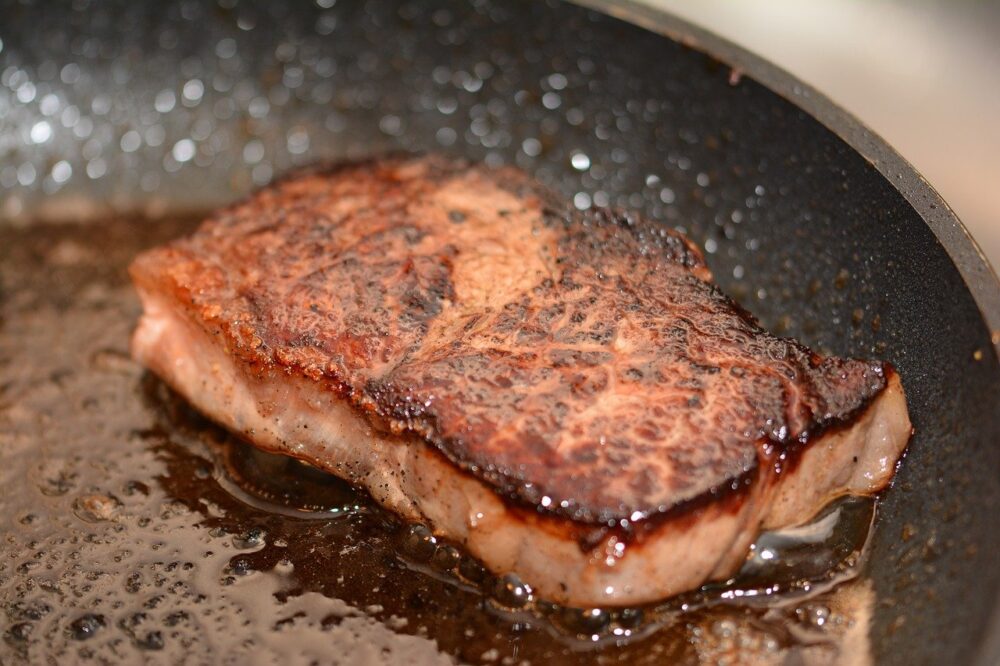Waking up to the smell of sizzling bacon and crispy toast can be a delicious way to start your morning. The bacon’s slight curls with crispy edges and the bread’s golden brown coloring are both caused by the same chemical reaction. Also known as the “browning reaction,” the Maillard reaction occurs during many different cooking processes — frying, toasting, roasting meat, baking cookies — and is critical for the aromas and flavors in cooking a variety of food groups.
The Maillard reaction is a nonenzymatic chemical reaction that occurs between an amino acid and a reducing sugar. The reactive carbonyl group, a carbon double bonded to an oxygen atom, usually reacts only at temperatures greater than 290 degrees Fahrenheit with the amino group, a nitrogen bonded to two hydrogens, on the amino acid to produce molecules that strongly contribute to why food smells and tastes so good.
This reaction usually occurs under specific conditions. In baked goods, baking soda can increase the dough’s pH, making the environment more basic and thus speeding up the reaction. When pan searing, higher temperatures and drier pans cause the water to quickly evaporate out of the food, increasing the concentration of sugars and also speeding it up. Although high heat is needed for this reaction to occur, when it surpasses around 350 degrees Fahrenheit, the Maillard reaction is overtaken by pyrolysis, which causes the food to burn. This charring often tastes bitter and appears black, which is neither desired by chefs nor eaters.
With 20 different amino acids, a variety of products can be made, such as pryzazines, furanones, and pyrroles. These products account for roasted, caramel-like, and cereal-like aromas and flavors, respectively. In any one food, multiple amino acids are present in varied amounts. The small differences of amino acids concentrations are responsible for the difference between the smell of bacon versus the smell of toast.
Though French chemist Louis-Camilla Maillard discovered the reaction in 1912, the mechanisms and the cooking implications were not truly understood until the 1950s. Even to this day, there still lies some mysteries in the mechanisms of certain products.
As a major chemical reaction in almost all cooked foods, it is extremely versatile and thus has many benefits along with some detriments. Some Maillard reaction products are known to be antioxidants, but one in particular, acrylamide, has been ruled a probable human carcinogen by multiple agencies including the International Agency for Research on Cancer, the US National Toxicology Program, and the US Environmental Protection Agency.
Acrylamide is the product formed from asparagine, a major amino acid in certain starchy foods like fries, potato chips, creeals, cookies, toast, and coffee. However, the amount of acrylamide produced greatly ranges based on the cooking time, temperature, and other minute environmental factors. Due to the specificity of the conditions, when studying the average intake of acrylamide in humans, it is difficult to determine exactly how much acrylamide people intake from potatoes, since it depends on how it was cooked.
There have only been a few studies since acrylamide was discovered in food in 2002. Most of these studies exploring the carcinogenic effects of acrylamide were conducted on rats and mice with very limited research on its effects in humans.
In a review by the National Toxicology Program, two-year studies were conducted on the carcinogenic properties of acrylamide in male and female rats and mice. The male rats showed clear cases of malignant mesothelioma along with some other rare forms of cancer. In females, fibroadenoma — or benign tumors — formed, along with some neoplasms, or abnormal cancer-like growth, of the oral cavity and skin were also observed. Similar results of carcinogenic activity were also found in male and female mice. However, the concentrations of acrylamide injected into the rats proportional to their mass is greater than the concentration that would typically be seen in humans.
Humans can be exposed to acrylamide not only through oral intake from certain cooked foods, but also from direct smoking, secondhand smoking, toiletries, or other household items. Thus, in humans, developing cancer due to acrylamide is from a combination of factors including environmental carcinogens.
The minimal research on acrylamide and the specific conditions for the Maillard reactions seem to suggest that it is only a mild carcinogen and not concerning enough because of the low production. Still, acrylamide is only one product of the Maillard reaction. Other products are essential for multiple stimulations in cooking and eating, which would make food quite dull and distasteful without them.
Sources:
Nutrition and Cancer (2014). DOI: 10.1080/01635581.2014.916323
